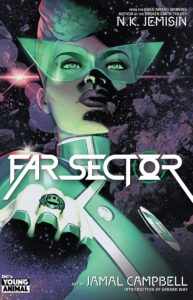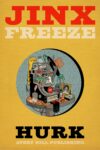
[DC Comics; 2021]
While there has always been some crossover of mainstream fiction, and even non-fiction, authors into the comics world, only recently has there been prominent non-comics authors jumping into the world of superheroes. Ta-Nehisi Coates and Roxanne Gay’s work on Black Panther, and elsewhere, showed particularly inspired examples of authors from outside the comics world taking the reigns of a complicated and often convoluted mythology, while other, somewhat less successful examples abound, such as The Other History of the DC Universe. What can be challenging is when writers want to port over the conventions that had enriched their prose work: it’s not uncommon to find novelists’ attempts at writing comics prolix, overwritten, and excessively expository. Comics are like any medium, they work best when the creators use the medium’s particularities to its fullest.
This is what makes N. K. Jemisin’s Far Sector such a triumph, it takes what made Jemisin’s world-building shine in her science fiction and fantasy work and finds a perfect match in the hyperreal story telling of the superhero comics. Jemisin is best known for the Inheritance Trilogy and other works that try to philosophically deconstruct our daily lives and social systems by fashioning the contours of a totally alien society: we learn about ourselves by looking at creatures who initially look nothing like us, until they suddenly do.
With Far Sector, she does something that has made earlier generations of DC comics so intriguing: she doesn’t just invent the mythology, she contorts it for her own storytelling. What made the first generation of DC/Vertigo comics so fascinating was that generation of comic book writers’ commitment to “deconstruction”: they took established superhero narratives, refashioned and reformed them, and built something that worked contemporarily, crafting the kind of narratives that allow genre fiction to act as a fractured mirror of ourselves. This approach slowly faded in the late 2000s as Vertigo turned more in the direction of creator-owned and genre work, and handed the DC characters back to the mainline series. It became uncommon to see someone like Alan Moore refashioning Swamp Thing’s origins to pick out the fears that run underneath our lives or Grant Morrison taking Arkham Asylum and shaping a frightening allegory of the encroaching threat of madness. The “mature readers” imprint left superheroes behind almost entirely, and even when creators put their own creative spin on these characters, they were doing so within the larger DC brand.
With DC Comics’ Young Animal imprint, emo star-turned-comic creator Gerard Way returned to this old Vertigo ethos with titles that reimagined 90s Vertigo favorites like Doom Patrol or revived forgotten characters with a new urgency, like Cave Carson and his cybernetic eye. And with the new DC Black Label imprint, DC created a space for adult superhero stories fashioned out of the regular DC canon and with some of that same flourish that made books like Animal Man so remarkable in the 1990s (though we have yet to see if a Black Label book can confront the established narratives for the characters).
Far Sector follows this approach. It is essentially a Green Lantern book, but written in a way that both honors its canonical precedents and is perfectly accessible for those who know little of DC’s arcane charts of continuity. The Lanterns are sort of an international police force (think Interpol, but intergalactic), and they are provided a sort of superpower in the form of a special ring that helps to take their thoughtforms and make them a material reality. Because Lanterns deal with planets across the universe, this is the perfect character vessel to create a speculative fiction story about a distant planet embroiled in a symbolic political battle. Our protagonist is Sojourner Mullein, a new Lantern with a traumatic history of being both a cop and a soldier: these roles let her down when she experienced, first hand, that neither role gave her the ability to do anything other than enforce inequality and violence. She is sent to City Enduring, a mega-metropolis composed of 20 billion residents divided between three races: the Nah, a “biologically” evolved race known for its aggressive carnivorousness, the heh-Topli, who evolved from plants, and the @At, a synthetic race that works like an evolved AI and has its own sense of space, culture, and language. The three had a history of near genocides in their failed attempts at co-habitation, so they found a solution: the Emotion Exploit, which muted the emotions of the residents almost completely. This created a tentative peace in the republic, and the three races cohabitated for thousands of years, until the first murder occurred in near history. Now Mullein heads in to start the investigation, which opens up a complicated political story, whereby profoundly different races try to find some shared pathway together through voluntary acts of oppression and restraint, an arrangement they think is the best they can hope for. All of this is called into question by the growing use of an illicit drug, Switchoff, which temporarily nullifies the Emotional Exploit, allowing the people to feel things, good and bad, in a way that seems anarchic for the well-composed society.
The plot moves quickly, so to save spoilers it is best to leave many of these developments to the readers, but what we end up with is a story that hits multiple levels of commentary. The racial implications, particularly of the manipulation of mass incarceration and economic inequality, are clear, yet always treated with an immense subtlety. Instead, it is the story and characters that are blasted in full color, and Jamal Campbell’s stunning comics art helps to make this rich narrative feel like a relatable and fun superhero story. The strangeness of City Enduring’s culture lends itself to look at some of the weirdest features of our own current culture: we are introduced to bizarre art objects turned currency like NFTs, the way that cultural production mines our own emotions, and how untranslatable many of our experiences are to people in vastly different positions of power. This is what science fiction allows us to do, to look at ourselves through someone else. The characters themselves are rich and engaging, they do not feel like totems used in archetypal morality plays, and while the story moves quickly and takes on added layers of complexity, it maintains a clarity that non-comics readers will find allows them to stick with it. It is the best of both worlds, independent science fiction and superhero comics, which is the kind of merger that rarely works.
There are no other Young Animal books on the horizon, and with DC Black Label now acting as the catchall for “mature readers” on DC, this could be the last one. But it does something that honors this tradition of pushing comics to the edge: it uses a vessel people understand (superhero narratives) to tell a story that they might otherwise find so challenging as to be impossible. Having recognizable character tropes helps stabilize the narrative, makes it easier to read, and the comic format itself allows the world building to be done smoothly. This elevates the form itself, honoring the expectations that readers have of these stories and then pushing them further. So much of comics history is about picking one of two lanes: either you do the conventional continuation of a classic comic story, or you attack the comics form itself and try to break out of the shell. Instead, Jemisin understands what works about superhero books and then uses it to move the readers through a narrative so subjective that they are forced to deal with some of the most profound political crises we have just lived through.
Far Sector did get acclaim, but not the popular recognition it probably should have. Now that it is in a collected edition (it initially ran as a twelve-issue maxi-series in single issues), it will hopefully see a second life. This was the model that Vertigo and a lot of smaller indie publishers have had to financially break even on the single issues and to make a small, yet noticeable, profit on the trade editions. Hopefully this is just the first comics effort from Jemisin, someone who clearly knows and loves the world of comics itself and doesn’t see the need to destroy its conventions to tell her own story.
Shane Burley is the author of Fascism Today: What It Is and How to End It (AK Press, 2017), and the recently published Why We Fight: Essays on Fascism, Resistance, and Surviving the Apocalypse (AK Press, 2021). His work has appeared in Jacobin, Salon, Truthout, In These Times, Waging Nonviolence, ThinkProgress, Political Research Associates, Alternet, and Roar Magazine.
This post may contain affiliate links.







